Yakuza: Dead Souls Review
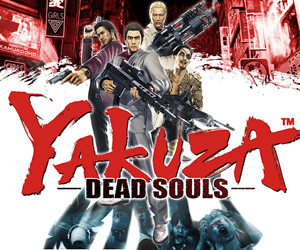 Game: Yakuza: Dead Souls
Game: Yakuza: Dead Souls
Developer: SEGA
Publisher: SEGA
Available on: PlayStation 3 only
Still a bit of an enigma in the West, the Yakuza series sells by the bucketload in Japan. In fact, it is one of the biggest game franchises in the Land of the Rising Sun, regularly raking in huge numbers. So much so that the series has seen PSP conversions and a feudal Japan spin-off title. The series has always had more than its fair share of quirks, and some of these may have led to the game never receiving the popularity it deserves in Europe and America, but perhaps it will possess more mass appeal with its latest addition? Yakuza: Dead Souls takes the world lovingly built in the first four titles and destroys it, letting loose a zombie outbreak to over-run the city. Zombies are very much flavour of the month, so will this new direction win the series some new followers?

STORY: As this game doesn’t follow the main Yakuza storyline directly (this world exists in a non-canon version of Japan, and events in this game will not affect the upcoming Yakuza 5 sequel), the developers don’t make quite the concerted effort to get players back up to speed as they did in the last couple of games. The main thing you need to know is that you once again take control of Kazuma Kiryu, the Dragon of Dojima, and protagonist of all of the past titles. In a continuation from Yakuza 4, the main storyline will be shared between Kazuma and three other main characters, and all three of them will be familiar to series fans. Goro Majima is a series favourite, being an eyepatch-wearing maniac, whilst the presumed-dead antagonist of the first two Yakuza games, Ryuji Goda, makes his return as a playable character, this time working alongside our heroes. Rounding out the group is Shun Akiyama, who only first appeared in Yakuza 4, but who is already a firm fan favourite.
The game begins before the outbreak has begun, and for the first few chapters you play the part of Akiyama, who unwittingly becomes involved in the start of the zombie problem as he is going about his normal business. An unknown man enters the headquarters of a group of Yakuza, promptly decimating them and infecting them with something that re-animates their bodies after death. As you can imagine, in the over-populated city of Kamurocho (based on Tokyo’s Red-Light district), the infection quickly spreads and zombies begin to grow in number and run loose. The Japan Ground Self-Defense Force move in to try and contain the outbreak, but as you can imagine, not everything goes to plan and most of them are wiped out.
As you progress through the title, you will switch between the four playable characters, who each have their own motivations and reasons for becoming involved in the zombie menace. Their stories will collide and meet, and further on in the title the group must work together to unveil the mystery behind it all. As with the last title in the series, which also saw four storylines, the team has carried on their fine work and the different plots all tie together nicely and inform each other through what you learn in one and take into the next. The zombie infection area also spreads and grows across the city as time passes. The further you get in the story, more of Kamurocho is fenced off into the quarantine zone, and less of the city is left as a safe-zone. This does add a palpable feeling of dread as you complete missions, when you are occasionally confronted with a cutscene to show the outbreak getting worse and the futile efforts of the Defence Force being pushed back. Only the four protagonists can stop the zombies from destroying the whole city.
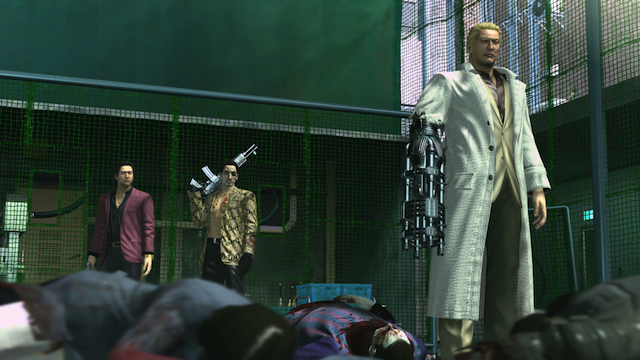
GRAPHICS: Very little has changed in terms of visuals since the last game in the series. Character models are near identical, as are the animation cycles. This isn’t to say that the game doesn’t still look visually impressive, the faces of the main characters are incredibly detailed and very expressive, meaning that cutscenes look stunning. Unfortunately it is still the case that there remains quite a stark contrast between the protagonists and the NPCs in the game. The unnamed masses may have been polished off a little, and look less blocky and faceless than before, but it remains true that NPCs don’t receive a lot of care and attention. This is a fully living city though at the end of the day, and you cannot afford the same luxury to the extras as the lead actors.
Kamurocho is still a great place to behold, but in its devastated post-apocalyptic state you couldn’t say that it is as beautiful as before. The half of the city which is fenced off in the quarantine zone is drab and grey, which plays negatively on the fact that the game has always drawn in gamers with its bright and vibrant colour palette. Of course, for a zombie game of this manner, this design choice is logical, but it does detract from the endearing qualities of the neon setting somewhat.
In terms of performance, unfortunately the frame rate also suffers, through the simple fact that there is so much going on on-screen. As you encounter huge swathes of the undead (particularly when in an enclosed space), the game may begin to stutter a little, and the use of heavy firepower or fire makes this even more obvious. Perhaps this is a symptom of using a game engine that was designed for a less action-orientated game in the past, and not a specialised one like we have seen in Dead Rising, for example. This does make the frantic zombie battles a little less engaging, and is a problem that is common, rather than fleeting.
SOUND: Sound design is another thing that could have easily been copied and pasted from the last Yakuza game. Sound effects and music both help set the atmosphere greatly, and the voice acting (albeit in Japanese) seems to fit the respective characters nicely. Now you have a real contrast of the lively, bleeping, blooping world of Arcade Machines and Crane games in the safe part of the city, where calmer tunes will play, set against the drab destruction of the quarantined area, where the only noises you hear are the groans of the undead, the screams of survivors and explosions from firefights. The two distinct audio environments create their own atmosphere successfully, and the quarantine area does become a place you want to hurry through and get out of as soon as you can, to the safety of the rest of the city.
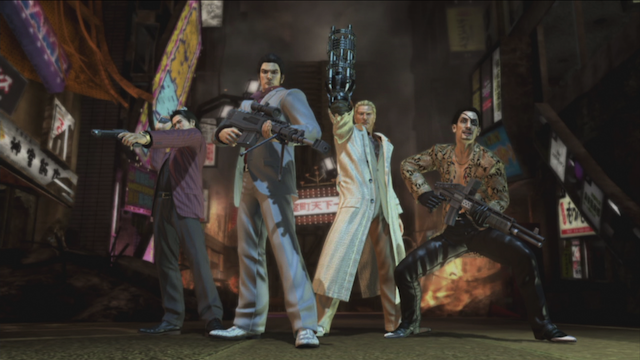
GAMEPLAY: What makes Dead Souls different from every other Yakuza game is the fact that melee combat has been almost entirely replaced by gunplay. Unfortunately, the gunplay feels dated and is more like that found in the Resident Evil series than an FPS. You cannot move whilst aiming, and the player is locked into shooting in the direction the character is facing rather than the way the camera is. This makes turning around and aiming a bit of a chore as the camera keeps swinging around and locking behind the player. You will be lucky not to feel dizzy after a while with the system.
There are a variety of weapons to make use of, and the action all takes place in the third-person, over the shoulder. It is fun to begin with, mowing down zombies with your weapon of choice, but considering the sheer amount of undead you will have to kill as you move along, the combat soon becomes repetitive and bland as there are few different attacks you can use to add variety to the system; whereas hundreds of martial arts moves could be accessed in previous games. Even the HEAT actions (where the player builds up energy which they unleash to perform skill shots) are quite limited. In the past, HEAT actions were context-sensitive and each character had a range of moves, but in Dead Souls they all largely consist of sniper shots of blowing up barrels and oil cans.
The enemies are quite bland also with the majority being made up of simple, limited zombies; they lunge and grab, and that’s about it. Some will wield weapons or Molotovs, but most can be avoided easily if you choose. Strangely, there are also a bunch of “mutated” zombies, who bear more than a close resemblance to the special infected found in Left4Dead. It was clearly a big influence as we find doppelgangers for the Boomer, Tank and Witch very quickly, all with similar powers. This smacks of unoriginality, and was somewhat of a disappointment from a development team who are usually teeming with silly ideas. The boss battles provide some added variety to proceedings, and some of these are truly epic but, once again, players will be reminded of Resident Evil, and these fights all come across a bit like a poor man’s Resi. This is a shame, as some thought has obviously gone in to making the boss battles feel important; they just don’t feel like they should be in a Yakuza game.
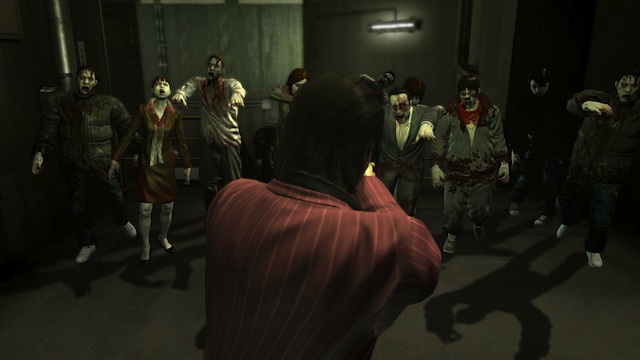
Little tweaks to the usual gameplay extras have been made, and some new modes have been added to the mix. Zombie Survival mode makes an appearance , and is quite self-explanatory, while Haruka’s Wish returns for a third game, where players try to complete tasks to make Kazuma’s daughter Haruka happy. Thankfully, one addition to proceedings is that the game finally has a fast travel system. This is something that fans and critics alike have been crying out for across several installments in the series, and now it finally arrives. Taxis are located around the edge of the city, in five or six locations, and will allow the gamer to quickly move between those different points. With such a huge city to explore, this really speeds up getting around the city, especially when you need to travel from one end of the map to another. These little additions only really help smooth out past issues, they don’t cover up the lackluster combat, and uninspired enemies.
MULTIPLAYER: As was also the case with Yakuza 4, there are a few options in terms of the multiplayer aspects of the game, however limited they are. Successfully playing through and attaining trophies in the single-player mini-games around the city (such as bowling and darts) will unlock the option on the main menu to play these games in two-player couch-based play. These are obviously fairly simple mini-games, but do give you something to take part in with a friend; although most of these games will have been done better elsewhere in multiplayer, and won’t hold much attraction. The other side of the equation is the fact that almost all of the mini-games in Yakuza: Dead Souls have their own leaderboards when you are logged in on the PlayStation Network. This way, when you play one of them, you can try to set a great score, or attempt to beat someone else who is currently riding high on the leaderboard. Neither of these options are likely to be much of a distraction though; but there is still plenty left to do in single-player.
LONGEVITY: Yakuza games have always been sprawling affairs, and Dead Souls is by no means any different. Playing through the stories associated with each character alone will take a good ten hours, and when you add into the equation that each chapter also contains a variety of side-quests and extra objectives to complete, there is an unimaginable amount of content on offer here. There is the ever-present lure of being distracted by the shops, restaurants and entertainment establishments in the city, they may not play such a prominent role as in past games, but if you wish to visit them, players can easily spend hours in a bar playing darts and drinking, or checking out the new range of karaoke songs on offer. There are so many mini-games and attractions to visit, you could literally ignore the main quest for hours. Your daughter has been kidnapped? It’s OK, you still have time to finish your dumplings and get a massage; the story will wait until you are ready. The game can be as long or brief as you make it, but the basic experience is still far from short.
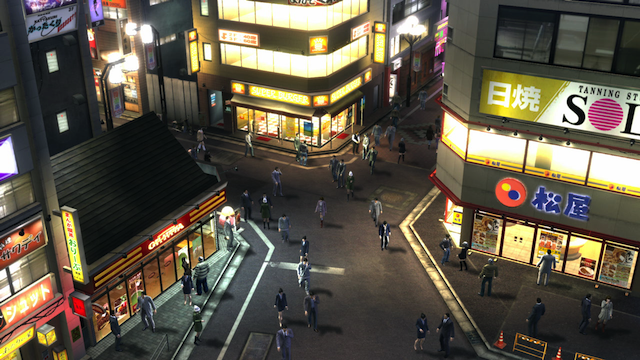
VERDICT: The game is still the same as its predecessors at heart, but the move away from martial arts and melee weapons to gunfights is far from a smooth one. Playing on its Virtua Fighter roots, the hand-to-hand combat always had a certain art to it, but the third-person shooting is clunky and feels outdated. There is no finesse in the system and it feels far less satisfying than what came before it. The story is also weaker than before, and it contains a lot less of the trademark offbeat humour that punctuated previous entries in the franchise. It is a shame, because there is still a cast of interesting characters, and plenty to get your teeth stuck into here and you could be playing the game for a long time yet to come before you experience everything. Missions still contain a lot of wit and clever design features that make them enjoyable, and we still care about our playable characters, making you want to play on and find the truth behind the outbreak.
However, when you consider the fact that the story and fighting elements don’t quite come up to snuff, yet the open world features (most of which have been present in both Yakuza 3 and 4) still entertain, the game almost comes across as a mod for an existing title. An interesting new take on an old game but not enough here to warrant a standalone title unfortunately. Whilst the team have been brave in attempting a new direction it will be far more interesting to see how far they can push themselves in developing and refining the traditional Yakuza gameplay for their next installment in the core series. Fans of the series will no doubt find plenty to enjoy here, but rather than the inclusion of zombies offering an entry point to the series for new players, the game has taken a step back and doesn’t hit the highs of past entries.





